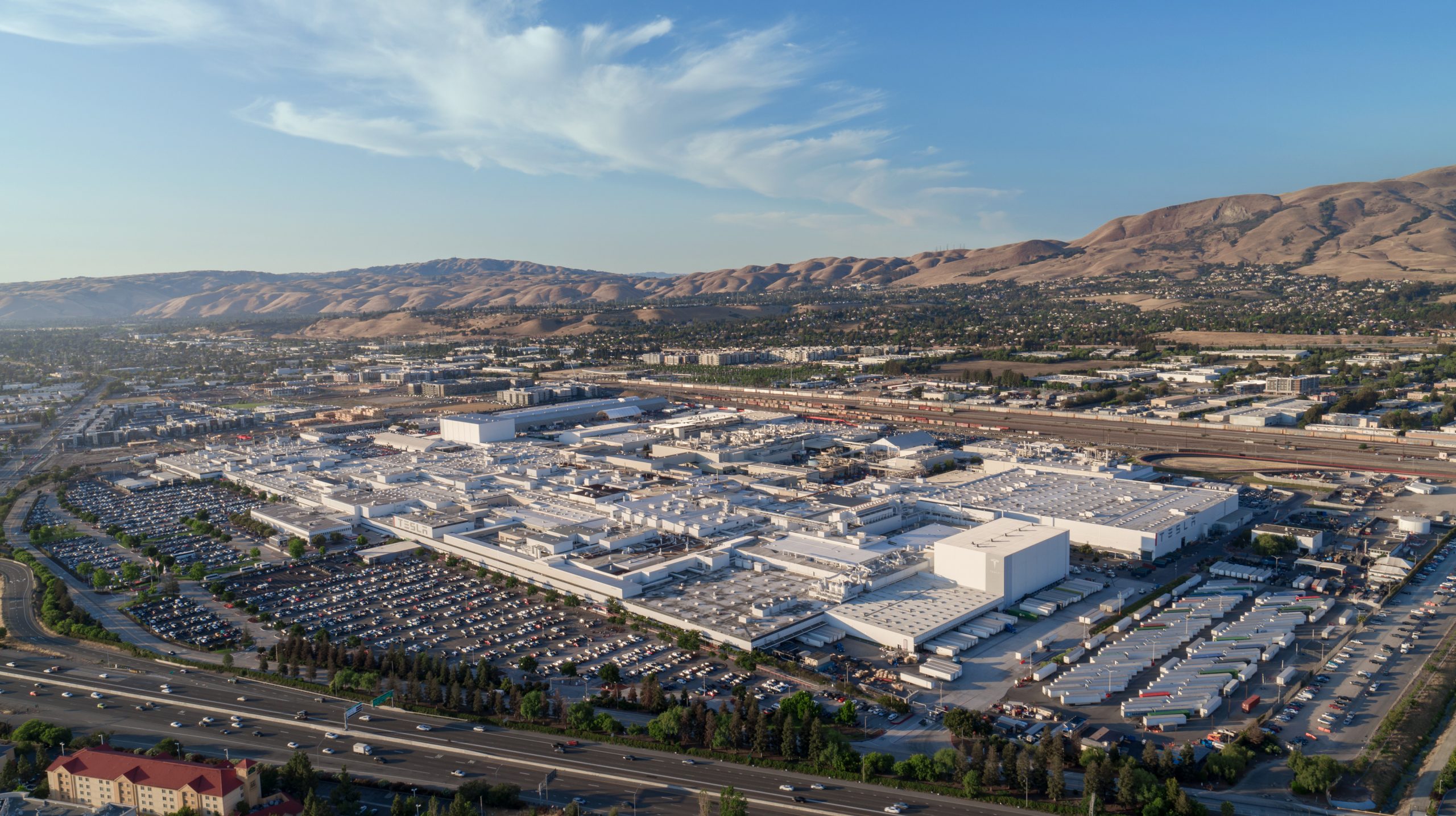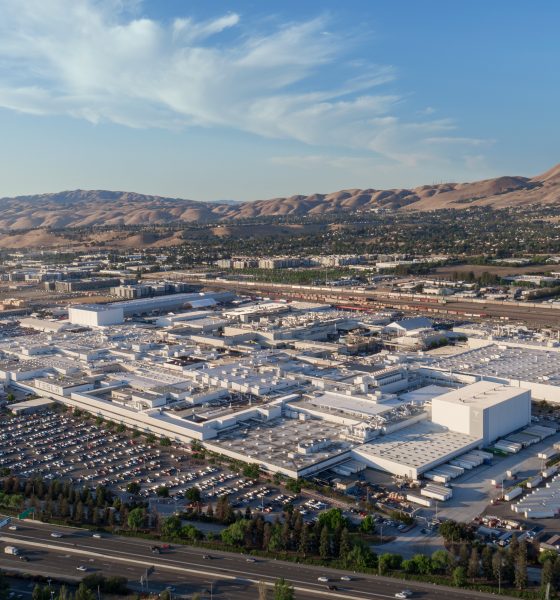

Investor's Corner
Tesla files to build EV batteries on new production lines at Fremont Factory
Tesla (NASDAQ: TSLA) has filed to build a new battery manufacturing equipment line at the Fremont Factory in Northern California. The factory, which Tesla purchased in 2010, is the only in the company’s lineup to produce all four models. It has not been known as a battery cell or pack manufacturing plant, as the company’s Gigafactory in Sparks, Nevada, produces those EV components. However, the filings indicate Tesla may be looking to slightly expand its cell manufacturing efforts with new production lines at Fremont.
Filed and signed by Tesla on August 30, the permit is labeled as “Tesla F21-0391-A – CTA Battery B-Build.” Tesla gives the following description of the project:
“NEW BATTERY MANUFACTURING EQUIPMENT LINE ON 2ND FLOOR OF MAIN ASSEMBLY BUILDING. THIS PERMIT APPLICATION RELATES TO THE MODULE PORTION OF THE LINE.”
The project is valued at $1.5 million, according to documents seen by Teslarati.
Credit: City of Fremont
Additionally, another application reveals a $1.3 million project that includes the installation of a new maintenance office, a storage area, production cells with equipment for hood, fender, and trunk lids, and offline cell manufacturing equipment. This project is listed to be on the first floor of the assembly building.
Interestingly, the Fremont Factory has been one of Tesla’s more spacially-confined facilities. Earlier this year, during a visit from Morgan Stanley analysts, including Adam Jonas, the firm noted the Fremont Factory was incredibly tight in terms of storage capacity and room in general. Despite running at a capacity of 20 percent above what has been considered its maximum. “The plant was never designed to produce 450k units (at its peak produced ~300k units before Tesla took it over from Toyota), which was immediately apparent at the tour, ” Jonas wrote in his note describing the visit. “Tesla does not shy away from the fact the plant is inefficiently designed with four assembly buildings, one of which is a tent that cars are assembled in,” referring to GA 4.5, which was made permanent last year.
Just two weeks prior to Morgan Stanley’s visit to Fremont, CEO Elon Musk stated Tesla was considering expanding Fremont “significantly.” While many of us just thought this likely meant an expansion of vehicle production alone, Musk may have been hinting toward an expansion of the manufacturing process altogether.
Tesla battery manufacturing efforts
Tesla has held battery supply deals with Panasonic, CATL, and LG Chem, but has also started building its own cells in-house. In 2020, Tesla unveiled its 4680 battery cell, which has already been prototype-tested by Panasonic. Tesla has been building the cell at the Kato Rd. facility just a few blocks away from Fremont’s front doors. However, the automaker has not scaled this cell to mass production as of yet, and Tesla could always use more battery cells.
With the 4680 cell not quite reaching mass production volumes yet, an order log that grows with what seems to be every minute, and a production volume that just simply has not caught up to Tesla’s demand, it would make sense to expand in-house battery manufacturing efforts as supplementary support.
“I think we’ve said this now for many years. I know has proven true. Tesla does not have a demand problem, we have a production problem. And we’ve almost always had it’s a very rare exception it’s always been a production problem,” Musk said after Q2. “I think that will remain the case.”
Rearranging at the Fremont Factory
Over the past month or so, Tesla has filed to make many significant changes at the Fremont Factory. After we reported on the construction efforts that are seemingly underway, Tesla has also been filing several applications with the City of Fremont for equipment repositioning, as well as the construction of new foundations and manufacturing equipment. Even things as simple as light poles are being repositioned to make way for potential new manufacturing buildings.
Tesla Fremont plant is abuzz with activity as nearby construction goes underway
Tesla has also started relocating Model S and X production equipment to other portions of the factory. “GASX,” which we can assume is “General Assembly Model S and X,” has had a hoist relocated, according to filings. Tesla has also filed to install production tools and other associated Model S and Model X manufacturing utilities in the factory. This does not necessarily imply that production lines for the two vehicles will be expanding, especially considering the vehicles make up an extremely small portion of Tesla’s overall sales. However, these manufacturing lines may be shifting to other locations at Fremont to make way for the perhaps imminent installation of cell manufacturing lines at Fremont.
I’d love to hear from you! If you have any comments, concerns, or questions, please email me at joey@teslarati.com. You can also reach me on Twitter @KlenderJoey, or if you have news tips, you can email us at tips@teslarati.com.

Investor's Corner
Tesla stock closes at all-time high on heels of Robotaxi progress

Tesla stock (NASDAQ: TSLA) closed at an all-time high on Tuesday, jumping over 3 percent during the day and finishing at $489.88.
The price beats the previous record close, which was $479.86.
Shares have had a crazy year, dipping more than 40 percent from the start of the year. The stock then started to recover once again around late April, when its price started to climb back up from the low $200 level.
This week, Tesla started to climb toward its highest levels ever, as it was revealed on Sunday that the company was testing driverless Robotaxis in Austin. The spike in value pushed the company’s valuation to $1.63 trillion.
Tesla Robotaxi goes driverless as Musk confirms Safety Monitor removal testing
It is the seventh-most valuable company on the market currently, trailing Nvidia, Apple, Alphabet (Google), Microsoft, Amazon, and Meta.
Shares closed up $14.57 today, up over 3 percent.
The stock has gone through a lot this year, as previously mentioned. Shares tumbled in Q1 due to CEO Elon Musk’s involvement with the Department of Government Efficiency (DOGE), which pulled his attention away from his companies and left a major overhang on their valuations.
However, things started to rebound halfway through the year, and as the government started to phase out the $7,500 tax credit, demand spiked as consumers tried to take advantage of it.
Q3 deliveries were the highest in company history, and Tesla responded to the loss of the tax credit with the launch of the Model 3 and Model Y Standard.
Additionally, analysts have announced high expectations this week for the company on Wall Street as Robotaxi continues to be the focus. With autonomy within Tesla’s sights, things are moving in the direction of Robotaxi being a major catalyst for growth on the Street in the coming year.
Elon Musk
Tesla needs to come through on this one Robotaxi metric, analyst says
“We think the key focus from here will be how fast Tesla can scale driverless operations (including if Tesla’s approach to software/hardware allows it to scale significantly faster than competitors, as the company has argued), and on profitability.”

Tesla needs to come through on this one Robotaxi metric, Mark Delaney of Goldman Sachs says.
Tesla is in the process of rolling out its Robotaxi platform to areas outside of Austin and the California Bay Area. It has plans to launch in five additional cities, including Houston, Dallas, Miami, Las Vegas, and Phoenix.
However, the company’s expansion is not what the focus needs to be, according to Delaney. It’s the speed of deployment.
The analyst said:
“We think the key focus from here will be how fast Tesla can scale driverless operations (including if Tesla’s approach to software/hardware allows it to scale significantly faster than competitors, as the company has argued), and on profitability.”
Profitability will come as the Robotaxi fleet expands. Making that money will be dependent on when Tesla can initiate rides in more areas, giving more customers access to the program.
There are some additional things that the company needs to make happen ahead of the major Robotaxi expansion, one of those things is launching driverless rides in Austin, the first city in which it launched the program.
This week, Tesla started testing driverless Robotaxi rides in Austin, as two different Model Y units were spotted with no occupants, a huge step in the company’s plans for the ride-sharing platform.
Tesla Robotaxi goes driverless as Musk confirms Safety Monitor removal testing
CEO Elon Musk has been hoping to remove Safety Monitors from Robotaxis in Austin for several months, first mentioning the plan to have them out by the end of 2025 in September. He confirmed on Sunday that Tesla had officially removed vehicle occupants and started testing truly unsupervised rides.
Although Safety Monitors in Austin have been sitting in the passenger’s seat, they have still had the ability to override things in case of an emergency. After all, the ultimate goal was safety and avoiding any accidents or injuries.
Goldman Sachs reiterated its ‘Neutral’ rating and its $400 price target. Delaney said, “Tesla is making progress with its autonomous technology,” and recent developments make it evident that this is true.
Investor's Corner
Tesla gets bold Robotaxi prediction from Wall Street firm
Last week, Andrew Percoco took over Tesla analysis for Morgan Stanley from Adam Jonas, who covered the stock for years. Percoco seems to be less optimistic and bullish on Tesla shares, while still being fair and balanced in his analysis.

Tesla (NASDAQ: TSLA) received a bold Robotaxi prediction from Morgan Stanley, which anticipates a dramatic increase in the size of the company’s autonomous ride-hailing suite in the coming years.
Last week, Andrew Percoco took over Tesla analysis for Morgan Stanley from Adam Jonas, who covered the stock for years. Percoco seems to be less optimistic and bullish on Tesla shares, while still being fair and balanced in his analysis.
Percoco dug into the Robotaxi fleet and its expansion in the coming years in his latest note, released on Tuesday. The firm expects Tesla to increase the Robotaxi fleet size to 1,000 vehicles in 2026. However, that’s small-scale compared to what they expect from Tesla in a decade.
Tesla expands Robotaxi app access once again, this time on a global scale
By 2035, Morgan Stanley believes there will be one million Robotaxis on the road across multiple cities, a major jump and a considerable fleet size. We assume this means the fleet of vehicles Tesla will operate internally, and not including passenger-owned vehicles that could be added through software updates.
He also listed three specific catalysts that investors should pay attention to, as these will represent the company being on track to achieve its Robotaxi dreams:
- Opening Robotaxi to the public without a Safety Monitor. Timing is unclear, but it appears that Tesla is getting closer by the day.
- Improvement in safety metrics without the Safety Monitor. Tesla’s ability to improve its safety metrics as it scales miles driven without the Safety Monitor is imperative as it looks to scale in new states and cities in 2026.
- Cybercab start of production, targeted for April 2026. Tesla’s Cybercab is a purpose-built vehicle (no steering wheel or pedals, only two seats) that is expected to be produced through its state-of-the-art unboxed manufacturing process, offering further cost reductions and thus accelerating adoption over time.
Robotaxi stands to be one of Tesla’s most significant revenue contributors, especially as the company plans to continue expanding its ride-hailing service across the world in the coming years.
Its current deployment strategy is controlled and conservative to avoid any drastic and potentially program-ruining incidents.
So far, the program, which is active in Austin and the California Bay Area, has been widely successful.








